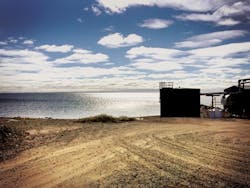About the author: Kalvin Reid is a senior consultant for Enterprise. Reid can be reached at [email protected].
Clean water—We cannot live without it, but too often we take it for granted.
We know that it is essential for life on our planet. We know that without it we cannot sustain the agriculture that feeds us. We know that we cook and clean with it.
But we also are too comfortable with the knowledge that clean water is only a turn of the tap away.
It is a big assumption. The hazards of tainted water can be extreme, causing illness or even death.
Not many of us give much thought to what it takes to ensure that the water sustaining our lives is clean and safe. But having a source of readily available potable water is one of the most important responsibilities of communities across North America.
This is especially true—although challenging—in remote communities. While there are lakes and rivers from which to draw water, proper facilities are needed to not only clean the water of impurities, but also ensure it is safe for human consumption.
These water and wastewater plants require maintenance and upgrades, and when you live in a community that is not accessible by road, making required repairs is not as simple as running to the local hardware store for parts.
Remote Location
In the Canadian Far North, off the northwestern shore of Hudson Bay in the territory of Nunavut, lies a mining community of approximately 1,800 people. It sits at the end of a freshwater lake, from which it draws water to be treated at a local plant. As with any community, this water is vital: It supplies the water for the drinking fountains of local schools, supplies the hospital with a safe and reliable water source, fills the community pool and serves the homes of the town.
The continuous operation of this plant is necessary for the safety and health of the community. At the heart of the plant’s operations is a control panel that manages, monitors and controls the flow of water into and out of the facility.
If the operating system running the panel at the water plant were to fail, every resident in the community would be at risk.
Technical Difficulties
In September 2016, the computer in the treatment plant crashed. Without the operating system running, every system in the plant stopped working. There was no information transmitting to turn on the pumps or open required valves. Unable to bring water into the plant and treat it for consumption and use, the threat of a tainted water scandal in the community was real.
The original supplier of the control panel was unable to address the situation.
As the clock ticked, the supply of available water for local residents was draining. The territorial government worked with partner Blumetric Environmental, a water, earth and energy company that addresses complex environmental issues in more than 60 countries, to contract Tulsar Canada to fix the problem.
Timing was of utmost importance, and within 24 hours of receiving the call and being briefed on the situation, a team of engineers from Tulsar’s Kitchener, Ontario, headquarters had gathered up the parts they thought they would need, began brainstorming possible solutions for hardware and software issues that may be causing the problem, and were on a flight north to one of the most remote settlements on the continent.
Emergency Response
Almost immediately after landing and arriving at the treatment plant, the engineers had assessed the root of the problem and began implementing the fix. Faulty parts in the control panel were replaced, and the entire system was rebooted. The fix then was tested to ensure the problem was resolved.
The team then assessed the entire system to identify future problems that may arise. The programming of the operating system was updated to allow the system to self-recover in the event of a future crash. Using a special code to instruct the processor to restart itself should a similar fault occur, the computer was taught to clear any bugs in the system and continue to run the water plant safely and smoothly.
Tulsar also made a series of recommendations that would enable easier and faster service to address problems in the software running the plant, including the installation of a remote modem to allow engineers to address problems in the system—whether troubleshooting or fixing faults in the programming—remotely from anywhere there is an internet connection.
With the problem addressed and safeguards installed to further protect the integrity of the system, the water plant was back up and running without any major interruptions in service—or threats to health and safety—for local residents.
